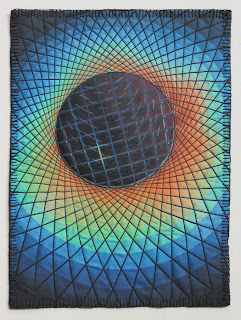When I first started creating The Clothesline Installation during a month-long art residency with the Springfield Art Association in Illinois, I saved all the scraps of fabric cut away from the hand prints. Each one had Wonder Under, a heat-activated adhesive, ironed to the reverse. I knew I could "do something" with these scraps but I didn't have a clear idea. I certainly didn't know that I'd have time during the COVID-19 crisis to use them.
(Above: Six of the Laundry Day Series pieces. Matted 20" x 16". With the mat, 11 1/2" x 7 1/2". Top to bottom, left to right: Care Instruction, Delicate Cycle, Dry Clean Only, Fabric Softener, Heavy Load, and Laundry Day. Matted at just $65 each.)
Many of the scraps still looked like hand prints (or at least the remains of fingers!) In a pile, they truly showed the signs of being handled or touched. They also looked like a small load waiting to be washed. It occurred to me that I could use these scraps as a daily design challenge.
(Above: Scraps of fabric cut away from the hand prints used for The Clothesline Installation.)
Without significantly altering the shapes, I started fusing them to canvas in pleasing arrangements. A little free-motion stitching united the shapes and added detail. I started doing one per day. By the time I'd finished the first eight, I had an action plan!
(Above: The Laundry Day Series. Matted 20" x 16". $65 each. From top to bottom and left to right: Lie Flat to Dry, Light Load, Low Heat, Mild Detergent, No Bleach Needed, and 100% Cotton.)
My plan was to make fifty works that would fit into a 20" x 16" mat, put them in appropriate Clear Bags for protection, and give each one a unique title referencing "Laundry Day". So far, I've finished the first twenty-four. More are waiting to be matted. More are waiting to be stitched. Soon, I'll post the rest. In the meantime, this post documents the first twenty-four.
(Above: The Laundry Day Series. Matted 20" x 16". $65 each. From top to bottom, left to right: Permanent Press, Pre-Wash, Remnants, Rinse and Repeat, Rinse Cycle, Soaking.)
I ordered a box of off-white mat board (25 sheets ... enough for 50 finished works). Mat board comes 32" x 40". Each piece was cut into four 16" x 20" sections. Two pieces were cut with the mat opening. On the other two pieces, the artwork was mounted/hand stitched in place. These were slid into an artwork protection package ordered from Clear Bags. There are a variety of sizes, plus ... some sizes come in a variety of thicknesses. The Laundry Day Series fit neatly into the thinnest 20" x 16" bag. Before sealing the flap, I slid a sheet of information, including a bio, a black-and-white photo of The Clothesline Installation and this statement:
The
Laundry Day Series developed alongside Susan Lenz's
Clothesline Installation, a project conceptually rooted in the
beauty of "doing things by hand" while promoting
conservation of household energy. Fabric hand prints were fused and
stitched to a collection of vintage linens. The excess fabric that
was trimmed away from the hand prints wasn't wasted. These scraps
were used for the abstract compositions in the Laundry Day Series.
Each work evokes the feeling of fingers, a human touch, and a
recycling mindset. There is a total of fifty works, each one with a
unique title.
(Above: Laundry Day Series. Matted 20" x 16". $65 each. From top to bottom, left to right: Soap and Water, Spin Cycle, Stain Blocker, Tumble Dry, Wash and Wear, and Wrinkle Free.)
This challenge has been a great way to jump start each day during the COVID-19 crisis. It has provided a small amount of time for composition, stitching, and presentation. Each one is only $65. If the country ever comes out from "sheltering in place" and holding exhibits, I'll have affordable work to accompany The Clothesline when it has a chance to be seen in public. Even if this never happens, I'm having a blast using the bits and pieces that might otherwise have been thrown away.
































































